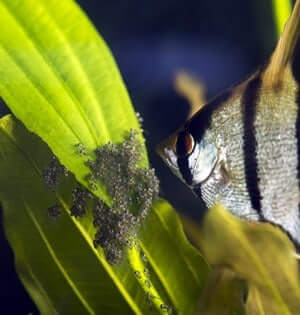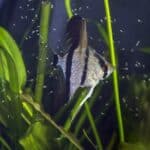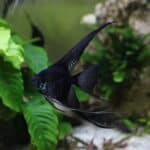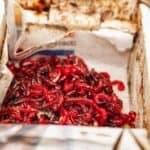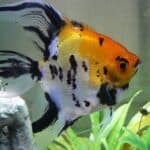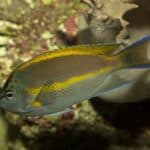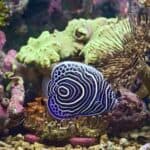Last Updated on: 16th November 2023, 01:29 pm
The lifecycle of angelfish undergoes complex stages as the fry grows from eggs into adults. Given the right conditions, the angelfish will reach maturity and begin reproducing.
Angelfish fry takes 6 to 12 months to become full-grown. During this time, they’ll begin as eggs that take 60 hours to reach the hatching stage.
They’ll become wigglers with a yolk attached. Then, they’ll consume the yolk and begin swimming after another 2 days. The angelfish will become juveniles in 16 weeks, reaching 20 millimeters.
They’ll continue gaining weight, size, and strength in the following months before adulthood. Once an angelfish has become full-grown, it can begin reproducing.
Under ideal conditions, an adult female will lay eggs every 12-18 days.
Angelfish Fry Growth Rate
Under the right conditions, the angelfish may live for 10-15 years. During this period, saltwater angelfish can reach 10 inches. However, freshwater angelfish are just 6 inches.
Angelfish will transform from fry to a sexually mature adult in about 12 months. Once this happens, it can lay eggs every 12-18 days. That way, it can find a mate and start anew.
Before the fry arrives, you’ll notice that mated angelfish does several things:
- Prepare the breeding site. The angelfish tidy up the area where the eggs will be laid. These will be the most stable and flat areas of the tank.
- Laying. The female angelfish will lay eggs before the male fertilizes them.
- Protection. The parents will safeguard the eggs from other fish and keep themselves clean. Fungus, sediment, or other material touching the eggs will be removed.
The parents will defend their eggs from all dangers and threats.
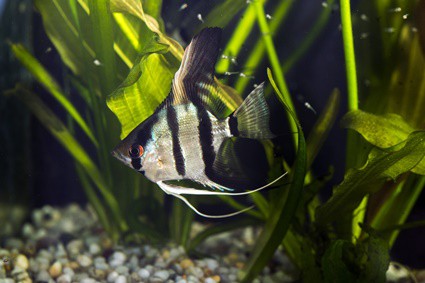
Stages of Growth
Once the eggs are fertilized, the fry begins their lifecycle.
Here’s the journey from conception to adulthood:
Germination
Over 60 hours, the eggs will brew. During this time, the sperm works through the individual eggs and begins the complex development cycle. Inside, the fry will start to develop tissue, organs, and other necessary body parts on a microscopic level.
Hatching
After 60 hours, the eggs will hatch. You may see little tails wiggling and squirming from the soft egg sac. At this stage, the fry are turning into wigglers. They’re still connected to the yolk sac for nutrition.
Wigglers
Growth continues on the 3rd and 4th days.
The tails of the fry will elongate, and the size of the yolk sac will reduce. The eyes of the baby angelfish will begin to take shape and become more prominent.
The wigglers are still connected to the yolk sac. They will thrash their tails with more energy, trying to break loose and swim to freedom.
Free Swimming
The wigglers finally become detached by the 6th or 7th day, so they’ll be seen swimming in the tank.
By this time, there’s no sign of the yolk sac because the fry has consumed it entirely and has the necessary energy to move about independently.
Detachment from the yolk sacs means more freedom. However, the fry must now locate food to keep up their high-paced growth cycle.
In the wild, they would immediately begin foraging and scavenging. The fry should be given microworms in captivity because there’s no yolk sac for nutrition.
Juvenile
The fry will swim on their own and seek food. Their appetites will be healthy, and you should provide nutrient-dense food 4 times every 24 hours. They’ll need more sustenance than adults.
For the first 2 months, give the baby angelfish frozen and live food.
Have both available because they’ll need dietary variety. You may need to isolate the fry into a separate tank because mature angelfish sometimes eat their fry.
They may get their natural hunting instincts and territorial behavior mixed up with their parental instincts.
You may notice some of the baby angelfish growing larger than others. Some may lack the right amount of food if there’s a stark difference. If the difference is minor, this is normal.
Angelfish grow at their own pace, some pulling ahead of others due to genetic differences or minor changes in their tank conditions. Overall, the angels should reach the following:
- 18 millimeters in 10 weeks.
- Up to 20 millimeters in 16 weeks.
Teenage
The angelfish will grow a few millimeters every week. After 6 months, they should be 4-5 inches.
Depending on the species, the fish may cap out at this size. If it’s a larger breed, like the common pterophyllum scalare, they’ll gain an extra inch over the next 6 months.
Apart from that, the clearest sign of growth is how the eyes grow proportionately to the body. As a fry or juvenile, the eyes will be thick and bulgy, seeming out of place on the angelfish’s head.
As it passes through its teenage stage, its body will grow while the eyes stay almost the same. Eventually, the bulging will subside, and the eyes will be smoother on the face.
Adulthood
You’ll know the angelfish has reached adulthood when it displays sexual maturity.
If you keep a single-sex tank, this may be harder to tell. In a mixed tank, the males and females will show attraction to each other. Breeding season will see them:
- Swimming quickly and erratically to impress mates.
- Fighting with others of the same sex to assert dominance.
- Spending their time exclusively with one angelfish.
- Preparing an area for breeding.
- Producing eggs or fertilizing them.
If you can’t find indicators of sexual maturity, trust your eyes and the calendar. If an angelfish has reached its maximum size and 12 months have passed, you have an adult.
How To Make Angelfish Grow Faster
There are ways to expedite the growth cycle. The limiting factor in an angelfish’s growth is the condition of its tank. If you’re able to provide an ideal habitat, the fry will be able to:
- Better process nutrients.
- Focus more energy on growth than on surviving.
- Experience less stress, a factor that stunts hormone development.
- Have more space to explore.
Wild angelfish are exposed to climate change and predators, which can stunt their growth or shorten their lifespan. You can provide more controlled conditions.
Here’s how to help baby angelfish reach adulthood sooner:
Tranquil Waters
Angelfish aren’t strong swimmers, even though they’re fast-paced.
When presented with fast-moving water or strong currents, they become exhausted. Nutrients and energy will be devoted to fighting the water rather than growing.
Provide tranquil waters and a low-flow pump. The tank must be oxygenated, so it can’t be entirely still.
No Overcrowding
Separate the fry from other fish, including their parents.
Fry can live in schools on their own and may enjoy the company. However, adult fish, fish of different species, or growing angelfish later in their growth cycle can be dangerous.
This may lead to fighting, cannibalism, or the fry being chased. This burns energy, increases stress levels, and stunts growth. At worst, they may get eaten.
Compartmentalization
If you only have one tank or have several groupings of fry, you needn’t get several new aquariums. Instead, separate the fish using netting, a fry basket, or another container.
The fry can be enclosed in an area while sharing water in the tank.
Hiding Places
As angelfish grow through their teenage stage, you can introduce them fully to the tank. When you do, ensure they have ample hiding places. This will allow them to:
- Isolate themselves from conflict.
- Hide from larger or more aggressive fish.
- Hunker down for rest.
- Have spaces to feel safe when stressed.
Moving around the existing decorations and plants is advisable. This will muddle up the territories of other fish, meaning they’re less likely to see the fry as newcomers.
Artificial Plants
Angelfish are still building their immune systems, making them more vulnerable to sickness, disease, and injury. If they survive bad encounters with pathogens, their growth may be stunted.
Only use artificial plants that have been sanitized. While live plants are a natural, healthy addition to tanks and can improve oxygen levels, there are more contaminants.
Avoid introducing new fish to the tank throughout this growth period.
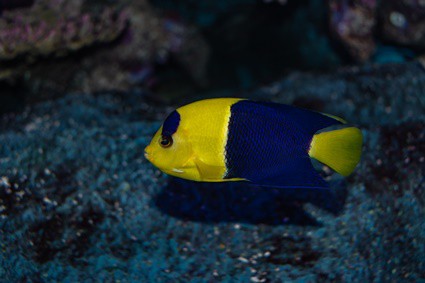
Right Food
The growing fry will see an impressive size increase if they’re well-fed. There’s a direct connection between feeding and faster-paced growth. A diet should include the following:
- Microworms.
- Brine shrimp.
- Blood worms.
- Protein-dense pellets.
- Vitamin-rich flakes.
Worms and shrimp can be offered frozen, dried, or live.
When the angelfish are still small, you may need to dice up their food before feeding. If they can’t easily fit it in their mouth, it may sink to the bottom of the tank and create waste.
The angelfish may also become underfed, even if provided with food 4 times daily.
Give the angelfish as much food as possible, as there’s little danger of overfeeding at this stage. Any uneaten food will float to the top or bottom of the tank, which you can clean out.
Tank Size
You may assume that tiny fish don’t need much space, but the opposite is true. If the angelfish fry are given a sizable tank, they’ll grow faster for the following reasons:
- Feel less constricted.
- Able to swim and exercise.
- Less stressed about overcrowding or territories.
- Can map out larger territories.
According to the Oceanic Institute, tank size positively affects reproduction, meaning adult fish produce more fry in large tanks. For 2-3 angelfish, you need at least 45-55 gallons.
It’s okay to start with a 20-gallon tank while fish are in the wiggler and juvenile stages.
Cleaning Routine
Angelfish experience illness, hormone imbalances, and stunted growth in dirty tanks. Maintaining a rigorous cleaning routine in an aquarium with fry is essential.
Install a filter, remove uneaten food, and change the water monthly. Water changes should be performed more often if you have many fish because waste accumulates faster.
Tank Conditions
Angelfish grow faster when kept within their ideal parameters.
While angelfish are hardy enough to survive slightly different conditions, this may result in your fish growing slowly or not reaching its full size. Monitor the levels of the following:
- Ammonia.
- Nitrates.
- Nitrites.
- Temperature.
- pH.
- Light.
Angelfish thrive with a pH range of 6 to 8 and a temperature of 75 to 84 degrees Fahrenheit.
According to the Journal of Fisheries and Aquatic Science, these parameters can improve their growth rate. This will help them fight illnesses or sudden environmental changes.
Light is also essential, with a minimum of 12 hours needed.

